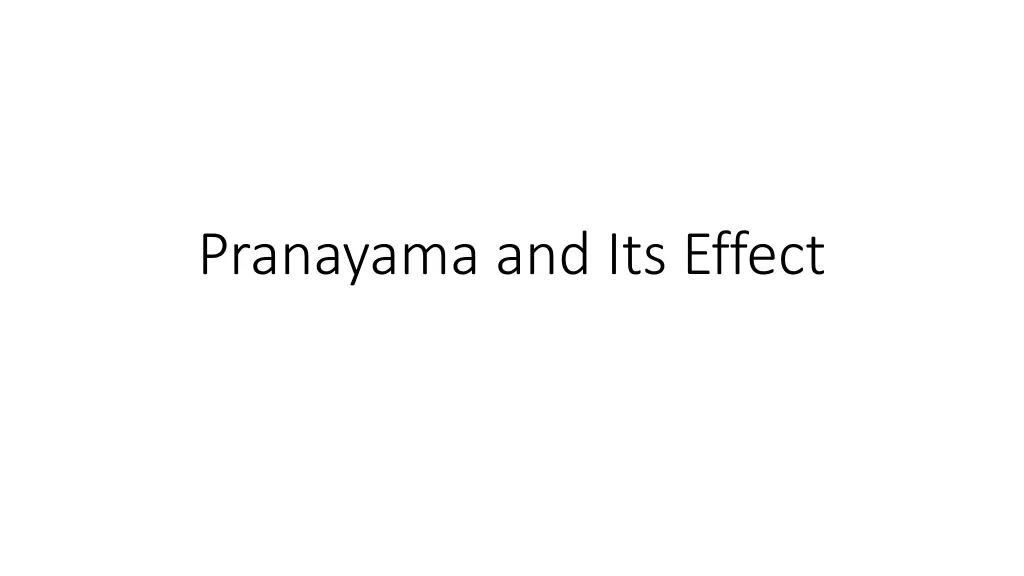
Explore the Art of Pranayama for Health and Wellness
Discover the ancient practice of Pranayama, which involves controlling the breath to enhance the flow of oxygen in the body. Learn about its definition, processes, modern classifications, and various techniques like Paschatya, Sahaj, Bhramana, and Hathayoga Pranayama. Enhance your well-being by incorporating these practices into your daily routine.
Download Presentation

Please find below an Image/Link to download the presentation.
The content on the website is provided AS IS for your information and personal use only. It may not be sold, licensed, or shared on other websites without obtaining consent from the author. If you encounter any issues during the download, it is possible that the publisher has removed the file from their server.
You are allowed to download the files provided on this website for personal or commercial use, subject to the condition that they are used lawfully. All files are the property of their respective owners.
The content on the website is provided AS IS for your information and personal use only. It may not be sold, licensed, or shared on other websites without obtaining consent from the author.
E N D
Presentation Transcript
Definition of Pranayama Pranayama is the practice of interrupting the movement of breathe and controlling it according to one s wishes. Pranayama= prana+ ayam Prana means breathe ayam means growth or expansion Pranayama is the process of increasing and expanding the flow of oxygen in the body.
Process Three process of Pranayama Purak: Process of pulling the outside air inside Kumbhak: The state of trapping air inside Rechak: The process of expelling the inside trapped air outside.
Classification of Pranayama(Modern) 1. Paschatya Pranayama 2. Sahaj Pranayama 3. Bhraman Pranayam 4. Vedic Pranayama 5. Hatha Yoga Pranayama
Paschatya Pranayama 1. It is a technique of regulating breathing in proportion to the movement of body s organ. Breathing along with movement of limbs causes a lot of oxygen to flow in the blood and purifies the blood which results in the relief of diseases in the body.
Sahaj Pranayama Sahaj Pranayam is a yogic action performed through long breathing without resorting to KumbhaK. When practicing this pranayama, the level of Rechak should be higher than Purak , which helps to remove unwanted substances accumulated in the body . All ages can practice this pranayama.
Bhramana Pranayama Bhramana pranayama, also sometimes referred to as bhraman pranayama, is a simple breath exercise to incorporate into a walking practice. It is a great technique that can be used as a standalone walking meditation, or combined with a mindfulness exercise to increase the focus surroundings and attention to your
Hathayoga Pranayama 1. Suryaveda 2. Ujjayae 3. Shitkalri 4. Shitoli 5. Bhastrika 6. Bhramori 7. Murccha 8. Plaboni
Benefits Yoga gurus suggest that the best time to practice pranayama and yoga, in general, is Brahma muhurta early in the morning and on an empty stomach. Ideally, pranayama should be practiced in an open space with good air quality. It s advised to practice pranayama in seated comfortable postures only. Initially one can begin by simply watching their natural breath and then try different techniques. It s also recommended to combine different types of mudras with pranayama breathing to deepen its effects. Each type of pranayama can arouse particular regions of the brain and affects the body differently. You can give each a try. Here are 8 types of pranayama breathing techniques.
Surya Vedana Pranayam In this pranayama practice, respiration is done with right nostrils only This is called surya vedana as the right nostril is associated with sun energy. Procedure : 1.Sit in any Dhyanasana with spine straight and relax. 2. Close left nostril and inhale with right nostril. 3. Close right nostril and exhale with left nostril 4. Respiration should be as long and deep as possible. 5. This exercise should be done 10/20 times or more consecutively.
Benefits 1. Help to cure flue 2. Sinusitis and other diseases 3. Provides vitality 4. Helps to relieve anxiety 5. Helps to fight Fatigue 6. Manage Mental Health
Bhastrika Pranayama In contrast to slow and deep breathing, bhastrika pranayama comes in fast and short breathing type pranayama. Bhastrika literally means bellows breath In this pranayama, exaggerated and forceful breathing is performed engaging the diaphragm and abdominal muscles. Rapid expansion and contraction of abdominal muscles create a bellows action to ignite the body s heat, hence also known as breath of fire.
Benefits Bhastrika pranayama is very effective in revitalizing the working of the lungs. In a 2019 study, bhastrika pranayama effect on lung function is tested among 30 healthy individuals and it has found; A significant increment is observed in the Forced vital capacity, forced expiratory volume in the first second, Peak expiratory flow rate, and maximum voluntary ventilation. The elastic recoil of the lungs and chest wall increased thereby strengthening the respiratory muscles.
Benefits In 2009, another scientific study on the effects of bhastrika on heart rate and blood pressure conducted. This time slow pace bhastrika pranayama is performed for 5 minutes followed by the measurement of blood pressure and heart rate. The comparative study between the readings of given parameters before and after bhastrika concluded that: There is a significant reduction in systolic and diastolic blood pressure. A slight decrement in the heart rate. The parasympathetic nervous system is also stimulated which bought a sense of calmness and reduces stress
